An Excerpt from a Report by Tim Lever
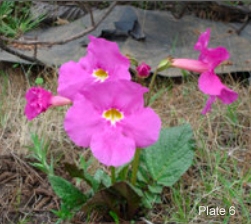 The Gang Ho Ba (3083–3426m)
The Gang Ho Ba (3083–3426m)
Set in the Jade Dragon Mountains above the city of Lijiang the unique geology of the Gang Ho Ba provides a wide range of habitats for the rich array of flora that inhabits its misty corners. An ancient glacier, long since retreated, left behind a long tongue of moraine, primarily composed of dolomitic limestone, which thrusts out into the rivervalley from the mountains. The large volume of rock that makes up the steep sides of the lateral and terminal moraines is a true testament to the power of ice.
The terminal moraine and the valley below is a mixture of open grassy areas and
coniferous scrub, the latter with an understory of Quercus semicarpifolia and several
dwarf rhododendron species including Rhododendron yunnanense, R. oreotrephes and R. racemosum. The grassy plains are carpeted with Roscoea humeana and both the
yellow and the purple forms of R. cautleyoides (Pl.3). These are interspersed with the
large lobed leaves and imposing violent pink trumpets of Incarvillea mairei var. mairei
(Pl.6). The conifer scrub, which gets thicker as height is gained, is interspersed with the
large pinnate leaves of Rodgersia sambucifolia alongside spikes of the deep wine red
flowers of Paeonia delavayi, the plant in the wild being much more compact than in
cultivation, while grassier open glades are home to Primula pulchella with its lax umbels
of yellow-eyed purplish blue flowers held on short stems.
Continuing up the slope, Pleione bulbocodioides (Pl.4) was found growing on moss-
covered rocks beside the path. Care had to be taken in this humid area to avoid the
attention of the leeches that stretched hungrily out towards the warmth of anything
passing. Once over the ridge of the moraine the valley of the Gang Ho Ba could be
glimpsed through the drifting mists as it opened out. The base of the valley consists of old
moraines, inundated with lime rich glacial silt that must be washed down annually when
the snows melt. The flora of this area includes Aster souliei and Anemone demissa and
offered another sighting of Androsace spinulifera, its characteristic sharp claw at the tip
of each leaf with large umbels of bright pink flowers standing tall amongst the grasses.
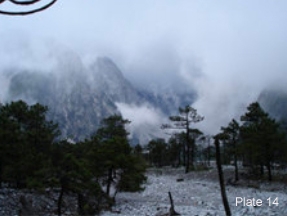 Further up the valley floor the light coniferous scrub returns and three different orchids
Further up the valley floor the light coniferous scrub returns and three different orchids
were found in its shelter. The burnt yellow flowers of Oreorchis eythrochrysea were found growing alongside the diminutive Cypripedium plectrochilon, the latter easily identified by its distinctive beard beneath each small pink flower. Close by a small flowered form of Cypripedium flavum was found. In the wild in Yunnan this yellow flowered species appears to exhibit a wide range of flower sizes with varying degrees of freckling.
Further up again, the valley floor turns very rocky and there are channels between the
trees that are obviously kept open by the spring snowmelt (Pl.14). These open rocky areas still harboured plant life, most notably Gentiana szechuanica (syn. georgii) just
beginning its growth for the season, its flowers due in August.
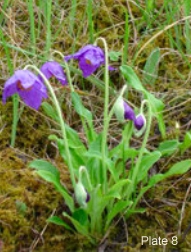
The lateral moraines on either side of the valley are forested with conifer woodland, the
south side more heavily than the north. The habitat under the tree canopy is much more moist and humus rich than is the mineral rich base of the valley. Here we found our first
examples of Meconopsis delavayi (Pl.8), its splendid indigo-blue poppy flowers making
the most of these conditions, along with Saxifraga rufescens and the tiny white bells of
Ophiopogon intermedius (Pl.13). The huge deep red slippers of Cypripedium tibeticum
(Pl.7) were also found growing in these humid conditions, the water dripping from the lip
of the flower, glistening in the gentle mist.
In more open areas of rhododendron and juniper scrub, two further orchid species were
found. Phaius delavayi (Pl.12) displayed its racemes of small delicate pink pleione like
flowers while the fabulous flower of Cypripedium margaretacium (Pl.10) held its single
blossom in the centre of large pale green spotted leaves. High up on the slopes, in rocky
breaks in the tree cover, single rosettes of the rare Saxifraga signata, unfortunately yet to lower, were growing alongside extensive mats of Androsace rigida already gone to seed. The vividly acid yellow flowers of Primula forrestii colonized the more vertical rock crevices, whilst steeper grass slopes played host to the furry rosettes of Corallodiscus
lanuginosus.
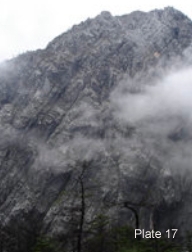 At the top of the valley the landscape changed again and the lateral moraines gave way to magnificently stratified cliff faces crying out for exploration (Pl.17). On the ACE
At the top of the valley the landscape changed again and the lateral moraines gave way to magnificently stratified cliff faces crying out for exploration (Pl.17). On the ACE
expedition in 1994, large mature plants of Daphne calcicola were found growing in this
area. Indeed, there is a clone of D. calcicola in cultivation named D. calcicola ‘Gang Ho
Ba’. This time we found that the upper end of the valley floor had changed somewhat, with a fresh five metre deep river of rubble stretching from one side to the other and as far up the valley as we could see (Pl.15). Obviously a cataclysmic event had occurred here in the not too distant past as the rubble had yet to be re-colonized by plants. We later learned that several years ago, a glacial lake had burst its dam and inundated the area with the rubble. As a result we failed to find any mature specimens of D. calcicola and it looked likely that many had perished. We had to wait until later in the expedition to see and photograph this stunning plant.
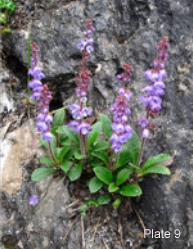
Older rubble screes, semi stabilised with deposits of loam were found under the south cliff face. These proved a rich hunting ground for plants that had survived the cataclysm that had befallen the valley floor below. Meconopsis rudis with its glaucous pale blue-grey leaves covered in purple spots, each with its own spine, was found sheltering under a plant of Thalictrum sp. aff. yavanicum. Here the papery, blue poppy flowers made a notable contrast with the yellow flowered thalictrum. Rodgersia sambucifolia was found in abundance in this habitat with one group of plants in full flower.
The stratified cliff faces provided a completely different habitat from any encountered elsewhere in this area. A continuous stream of water droplets from the upper cliff faces provided a damp humid environment for the flora growing in deep narrow cracks and crevices in the rock face. Their deep roots must have had near constant access to water. Paraquilegia anemonoides grew in vertical crevices alongside mats of kabschia saxifrage and the diminutive white Pinguicula alpina. The latter, which is also a European native, was the only one of the three found in flower. Most exciting of all was the discovery of Androsace alchemilloides, a single plant of which was in flower, the rest having gone to seed. The flower, which was pure white, was instantly recognisable as an androsace. However the very finely divided foliage was completely different, being one of the very few androsaces to have such leaves. A dwarf birch, Betula calcicola (Pl.16), was found here in its finest examples colonising near vertical cracks and crevices, alongside Veronica pyrolifolia (Pl.9). This desirable small veronica has many dainty purple flowers on an upright 10-20cm spike over little round leaves. I have not seen it in cultivation, but it could be a rewarding plant to grow.
After several days exploration of the Gang Ho Ba we had to move on. Zhongdian (Shangri- La) was the next destination and en route we encountered some interesting sights......
The Complete Report
You can find a copy of the complete report on the Merlin Trust website.
www.merlin-trust.org.uk/reports.html